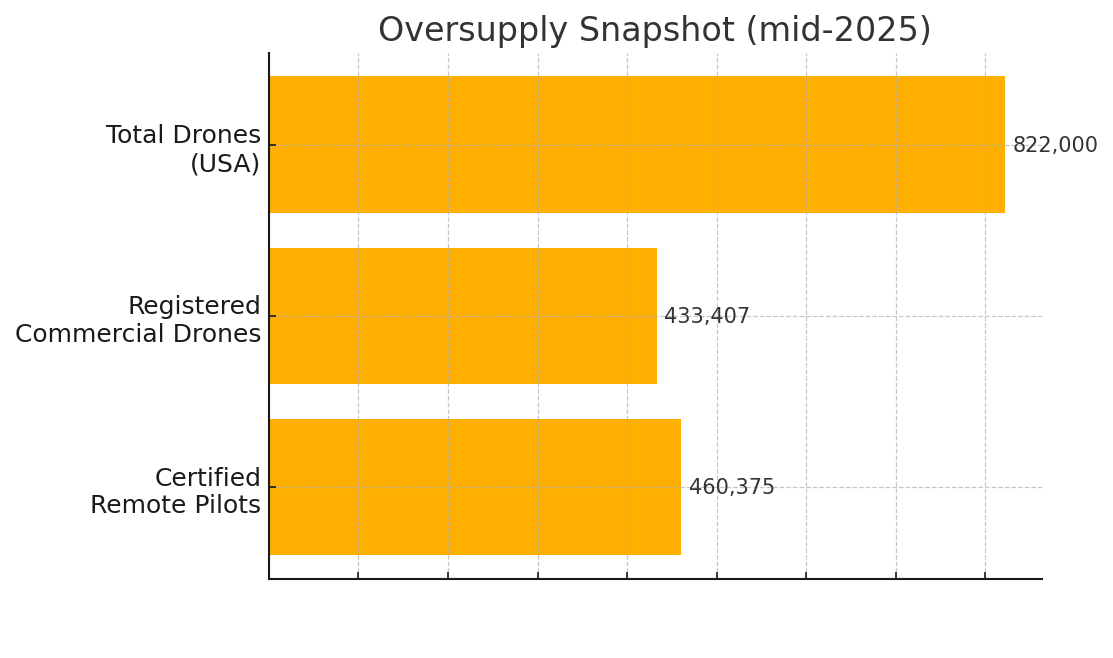- Home
- Guides
Part 107 is a Launchpad,
Not a Career Plan
When the FAA introduced Part 107 in 2016, it opened the door to commercial drone operations—no expensive flight school or Section 333 exemptions required. Study, pass a 60-question knowledge test, and you can fly commercially.
By 2025, the industry evolved. There are now more certificated remote pilots than registered commercial drones. Part 107 remains essential, but it’s no longer a differentiator—it’s the baseline. Building a career today means going beyond the written test to demonstrate readiness and professionalism.
Part 107 opened the door. This guide shows how to step through it—by layering real-world skills, safety leadership, and standards-based credentials that employers value.
This Guide Will:
Requirements & Format: You must be at least 16 years old, pass TSA security vetting, and successfully complete a 60 question multiple-choice knowledge test on aeronautical subjects. Recurrent training is required every 24 months and is offered online for free.
Quick Facts
Timeline
Why it was a game-changer — and why it’s not enough: Part 107 was designed for basic VLOS operations under predictable conditions. It wasn’t built for today’s realities like autonomous workflows, detect-and-avoid systems, or BVLOS corridor inspections. Employers now see “107-only” as incomplete — they want proof you can execute real-world missions safely and efficiently.
A Part 107 certificate alone no longer guarantees a premium job. With so many “107-only” pilots, basic tasks are commoditized.

There are now more licensed pilots than commercial drones to fly. Employers face a large pool of candidates who’ve passed the same test but have vastly different skill levels. Entry-level wages tend to stagnate where the work is basic, while roles requiring BVLOS operations, complex data deliverables, or program leadership command higher pay.
Example: A utility will pay far more for a pilot who can perform a BVLOS powerline inspection with formal risk assessments than one limited to standard daylight VLOS photography.
1. Hands-On Flight Proficiency
Part 107 doesn’t require a practical flight test. A pilot might ace airspace questions but struggle to manage a lost-link contingency or execute a precision landing in gusty winds. Many employers now include “stick checks” during hiring — tasks like capturing a specific nadir image set or landing within a marked zone.
2. Safety Literacy
Human Factors + Risk Management + SMS
Human error remains aviation’s leading risk. While Part 107 touches on weather and rules, it doesn’t build full competence in crew resource management, risk-based decision-making, or Safety Management Systems (SMS). Enterprises increasingly screen for this knowledge.
3. Mission Planning & Data Management
Successful missions require more than good flying. Pilots must plan routes, assess hazards, manage data, and ensure compliance with airspace and regulatory requirements — all skills taught in UAS Safety Level 2 and VSO Ground courses.
4. Advanced Operational Readiness
BVLOS, Waivers, & Emerging Tech
BVLOS operations require FAA waivers or compliance with upcoming Part 108 rules. Mastery of detect-and-avoid systems, communications protocols, and redundancy planning sets professionals apart.
*Safety Level Certifications*
Progressive competencies in UAS systems, maintenance, risk management, and advanced operations.
- UAS Safety Level 1 & UAS Safety Level 2 — foundational systems & safety.
- VLOS Operations — VSO Ground / Flight for standard ops.
- Adv. Unmanned Safety 1 & Adv. Unmanned Safety 2 — risk management, human factors, SMS.
- UAS Cybersecurity — (if available) broaden your skill set.
Specialized Endorsements & Skills
Targeted skills that set you apart in specific domains.
- BVLOS Readiness — prepare for beyond-visual-line operations.
- Thermal Imaging — IR inspections for energy & public safety.
- Mapping & Surveying — GIS and photogrammetry workflows.
- Sector-Specific Training — public safety, utilities, agriculture, inspections.
Final Thoughts
Part 107 is your entry ticket — not the whole journey. In a competitive field, success comes from combining regulatory compliance with real-world skills, safety leadership, and technical versatility. The industry rewards those who can demonstrate they are ready for complex, high-value missions.
Next Step: Explore USI’s full training pathway to see how you can progress from Part 107 to advanced, standards-based certifications that position you as a leader in the UAS workforce.
Ready to Go Beyond
Part 107?
Explore USI’s training pathway and elevate your credentials today.
